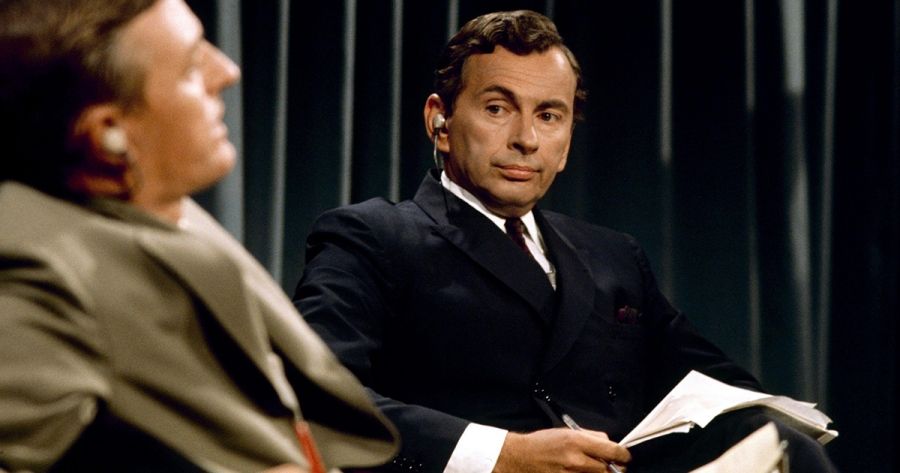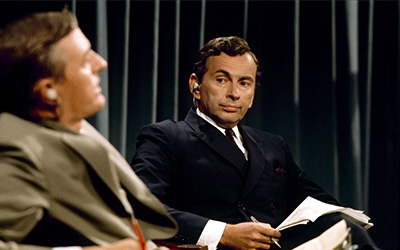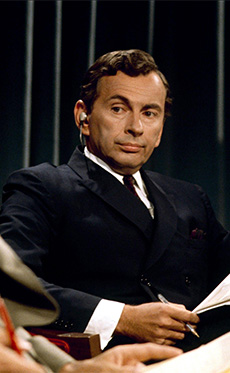
- Free Article: No
- Contents Category: Commentary
- Custom Article Title: Some sort of afterlife: Posthumous representations of Gore Vidal
- Review Article: No
- Article Title: Some sort of afterlife
- Article Subtitle: Posthumous representations of Gore Vidal
- Online Only: No
- Custom Highlight Text:
Gore Vidal (1925–2012) emphatically rejected any conventionally religious version of an afterlife. In an essay, ‘Armageddon?’ (1987), he contrasted his own view on the matter with that of Norman Mailer. ‘[B]ecause there is no cosmic point to the life that each of us perceives on this distant bit of dust at galaxy’s edge, all the more reason for us to maintain in proper balance what we have here. Because there is nothing else.’ Five years later, in Screening History, a meditation on the significance of cinema in his own life, Vidal suggested that the medium of film offers an alternative possibility of immortality.
- Featured Image (400px * 250px):

- Alt Tag (Featured Image): ‘Some sort of afterlife: Posthumous representations of Gore Vidal’ by Heather Neilson
From the 1970s, Vidal and his partner Howard Austen regularly moved between Italy and their home in Los Angeles. The actor Alan Cumming’s memoir includes a description of an evening at their villa in Ravello that is typical of accounts by those who experienced Vidal’s hospitality. Cumming’s visit occurred shortly after the 9/11 terrorist attacks. Arriving at the villa, he found both his hosts already inebriated. Vidal, who continued to drink both whiskey and sake throughout the evening, became increasingly aggressive towards Cumming. The night culminated in an explosive row between Austen and Vidal. The following morning, as Cumming recalls in Baggage: Tales from a fully packed life (2021), the two men greeted him as if nothing had happened. A more benevolent and substantial depiction of a night at La Rondinaia is included in John Boyne’s novel A Ladder to the Sky (2018). The novel’s protagonist is a ruthlessly ambitious and charismatic young writer who repeatedly steals the work of more talented authors. He has been brought to the villa by a hapless older admirer, a friend of Vidal’s. The only uninvented characters in the novel are Vidal and Austen. Boyne’s portrait of Vidal, in the context of his life in Ravello, is uncharacteristically flattering. He is the only person in the novel who is immediately able to discern the young man’s true malevolence and to confront him about his manipulativeness.
The theme of predatory writerly relationships, of ambivalence between mentors and their ephebes, was also at the heart of a biopic co-written by Michael Hoffman and Jay Parini, directed by Hoffman, and produced by Netflix. Set primarily in Ravello in the early 1980s, the film portrayed Vidal becoming infatuated with a young devotee who visits him and Austen at La Rondinaia. In 2017, the film was in post-production when allegations of historical sexual abuse, against Kevin Spacey, were first publicised. Spacey’s scenes in another film, All the Money in the World, were quickly reshot with the late Christopher Plummer. However, Spacey – in the role of Vidal – was in most scenes in the Netflix film, and reshooting was not feasible. Hence that film was promptly cancelled. It appears unlikely that the film will be made publicly available, although in the past year or so there have been a number of private screenings in the United States (email to the author from Jay Parini, 26 July 2022.).
When Julian Assange was forcibly removed from the Ecuadorian Embassy in London in April 2019, he was holding a copy of a book entitled Gore Vidal: History of the National Security State (2014), with Vidal’s face on the cover. The book itself comprises selected material from interviews which Paul Jay, co-founder of the non-profit organisation The Real News Network, conducted with Vidal at various times from 2005 to 2007. In the documentary Ithaka (2021), produced by Assange’s brother Gabriel Shipton, footage of the arrest briefly shows the book shaking in Assange’s hand as he strives to keep it in view of the surrounding cameras. Assange was evidently ‘sending a message’ by visibly associating himself with one of the twentieth century’s most trenchant critics of the United States.
In prose poetry published from 2020 to 2022, the Australian poet Jennifer Maiden meditates on the continuing plight of Assange from the perspective of Vidal’s ghost. Awoken as if by the presence of his own book in Assange’s possession, Vidal finds himself in a London Magistrate’s Court, or in the Old Bailey, or in Belmarsh Prison, where he solicitously contemplates the prisoner and reflects upon ‘the national security state’. In the ten poems in which she invokes Vidal, Maiden unsettles the poetic cliché of death as a kind of sleep, blurring the distinction between waking and sleeping, through which the apparitional becomes plausible. As Vidal watches the sleeping Assange, his might-have-been protégé also appears ghostlike. The awakening from oblivion is sometimes disorienting, as Vidal’s ‘reintegration’ is not always immediate. These poems implicitly raise the poignant question of whether, if the dead can haunt the living, the living might similarly disturb the dead by our very desire for ongoing connection.
The most substantial recent literary representation of Vidal is to be found in James Gordon’s play Best of Enemies (2021), inspired by a documentary of the same name which appeared in 2015. The play was performed in London from December 2021 until the end of February 2023. In November 2022, when the play transferred from the Young Vic to the Noel Coward Theatre, Zachary Quinto replaced the British actor Charles Edwards in the role of Vidal. The play is predominantly set in 1968, a pivotal year in American political history and a presidential election year. Rating poorly against the news divisions of CBS and NBC, ABC devised an alternative to the other networks’ coverage of the Republican and Democratic national conventions. The conventions took place in August in, respectively, Miami Beach and Chicago. ABC’s ‘Unconventional Convention Coverage’ brought together each evening the conservative William F. Buckley Jr and the liberal Gore Vidal, ostensibly to comment on what had occurred that day and to debate matters of concern to the nation.
In August 1968, Vidal and Buckley were both forty-two years old, already well-known public intellectuals, with considerable experience in front of television cameras. They detested each other. Buckley was staunchly Roman Catholic, from all appearances happily married. Vidal was an atheist and an advocate of promiscuity. That same year he had published the provocative Myra Breckinridge, which was arguably both a reflection of and an influence upon the burgeoning gay liberation movement. As the play comically depicts, Buckley (played by David Harewood) read the novel between the conventions, so as better to understand his enemy. Vidal’s first biographer, Fred Kaplan, commented:
At the Republican convention he had considered attacking Vidal as a pornographer – but he had not then read Myra. Now he had no doubt that Vidal was a pornographer whose credibility as a commentator on political events should be emphatically destroyed by that fact. For Buckley all political questions were essentially moral issues. Immoral people should have no political credibility.
The televised debates proved popular with viewing audiences. In Miami the exchanges remained just within the bounds of civility, but this abruptly changed on the night of 28 August, during the Democratic convention in Chicago. Crowds of mainly students protested near the Convention Centre, against American involvement in the Vietnam War. Footage of the violent police response to the protesters was played while Vidal and Buckley were on air, and they were invited to comment on the scenes. Buckley asserted that there were limits to the right to freedom of expression, and rhetorically associated the protesters with supporters of Nazism in World War II. Vidal replied that ‘The only crypto-Nazi I know of is you.’ Losing control of himself, Buckley retorted: ‘Now listen, you queer! Stop calling me a crypto-Nazi or I’ll sock you in your goddam face and you’ll stay plastered.’ The ABC cancelled the time-delayed West Coast version of the Chicago broadcast, and used static to cover the word ‘queer’ in its archival tape. Buckley had abandoned the tacitly accepted distinction between political insult and personal slur. Exacerbating the embarrassment, he subsequently published an attack on Vidal in Esquire magazine. Vidal responded, each sued the other, and ultimately the lawsuits went nowhere.
Best of Enemies ends with an imagined scene of rapprochement between the two men, in which, in response to Buckley’s accusation that Vidal had never really loved anyone, Vidal launches into a nostalgic paean to Jimmie Trimble, his high-school friend and alleged lover, who had been killed in the battle of Iwo Jima at the age of nineteen. In other words, the audience is offered a sentimental and ultimately misleading resolution. However, the play’s overt message – that the legacy of the Vidal-Buckley debates was a less civil, more counter-productive American political discourse – is expressed in an epilogue by the NBC news anchor David Brinkley. Brinkley – or rather his ghost in our present day – laments that all political discussion in the United States is now adversarial by default. What he cannot bear, he says, is ‘the normalisation, and the celebration of “hate”’.
In interviews included in the theatre program for Best of Enemies, both the playwright James Graham and the director Jeremy Herrin emphasise that the audience is intended to recognise the resonances between the period of crisis in the United States in the late 1960s and the current political situation. To quote Herrin:
I think we are in a moment of flux similar to 1968. A lot of the questions that are exercising us now remain unresolved from the period of the play. It’s a time-honoured tradition of drama to try and understand the present through the prism of the past ...
Early in the play, Patricia Buckley reminds her husband that he and Vidal are participants in ‘a battle for the soul of America’. Other characters in the play – especially Vidal – refer repeatedly to the United States as being on the brink of civil war, or of revolution at the very least. James Baldwin appears periodically, as something of a Greek chorus, warning those on stage and the audience alike to be attentive to the signs of the times. The assassinations of Robert F. Kennedy and Martin Luther King feature prominently in the play, as does the attempted murder of Andy Warhol two days before Kennedy was shot. The cultural critic and historian Richard Slotkin has observed (in Gunfighter Nation, 1992) that, after these assassinations, ‘the idea that events [in that year] were driven by some form of collective insanity, a congenital flaw in the American “national character” that produced an irrational “propensity to violence”, gained currency and credence’.
While Slotkin wrote those words more than thirty years ago, they are discomfitingly suggestive of the contemporary political climate. The phrase ‘battle for the soul of America’ is echoed in the rhetoric of the Trump and Biden campaigns. In 2020, supporters on both sides appropriated the phrase ‘battle for the soul of a nation’ to convey that more than just party politics was at stake. In 2020, at Gettysburg, Biden himself gave a speech entitled ‘Battle for the Soul of a Nation’. As president, he delivered another in Philadelphia, with the same title and message, before the mid-term elections in 2022.
Although Vidal predicted in the 1960s that ‘the people will march’, it is unlikely that he would have endorsed the actions of those who marched on the Capitol on 6 January 2021. It is tempting to wonder what Vidal would have said concerning the much-misunderstood American revolution in response to the insurrectionists’ chanting of ‘1776, 1776’ during their attempt to overturn the democratic election of a president. As another presidential election year approaches in the United States, Vidal will no doubt continue to be cited, for his profound knowledge of American history, his scepticism, and his prescience. So long as he continues to be invoked, on screen and in fiction, poetry, plays, and other cultural forms, his personality will survive – and not merely as ‘a ghost on a boring assignment’.
Reference List
Bloodworth, Adam, ‘David Harewood: White actors should be able to play Black roles’, City A.M., 24 November 2022.
Bogus, Carl T., Buckley: William F. Buckley Jr. and the rise of American Conservatism, Bloomsbury, 2011.
Bouthillette, Fabian, Gore Vidal’s Last Stand: My American initiation, self-published, 2014.
Cumming, Alan, Baggage: Tales from a fully packed life, Canongate, 2021.
Davidson, Guy, Categorically Famous: Literary celebrity and sexual liberation in 1960s America, Stanford University Press, 2019.
Frank, Marcie, How to be an Intellectual in the Age of TV: The lessons of Gore Vidal, Duke University Press, 2005.
Graham, James, Best of Enemies, Methuen Drama, 2021.
Hoffman, Michael and Jay Parini, draft screenplay for biopic about Gore Vidal, April 2016 (provided to the author by Jay Parini)
Kaplan, Fred, Gore Vidal: A biography, Bloomsbury, 1999.
Maiden, Jennifer, The Espionage Act, Quemar Press, 2020.
Maiden, Jennifer, Biological Necessity, Quemar Press, 2021.
Maiden, Jennifer, Ox in Metal, Quemar Press, 2022.
Mewshaw, Michael, Sympathy for the Devil: Four decades of friendship with Gore Vidal, Farrar, Straus and Giroux, 2015.
Parini, Jay, Every Time a Friend Succeeds, Something Inside Me Dies: The life of Gore Vidal, Little, Brown, 2015.
Slotkin, Richard, Gunfighter Nation: The Myth of the Frontier in Twentieth-Century America, Atheneum, 1992.
Vidal, Gore, ‘Armageddon’?, originally published in 1987. Reprinted in United States: Essays 1952-1992, Andre Deutsch, 1993.
Vidal, Gore, Myra Breckinridge, Little, Brown, 1968.
Vidal, Gore, Screening History, Andre Deutsch, 1992.
Gordon, Robert, and Morgan Neville (dir.), Best of Enemies, Magnolia Pictures, 2015.
Lawrence, Ben (dir.) Ithaka, Shipton House, 2021.
Scott, Ridley (dir.), All the Money in the World, STX Entertainment, 2017.
Wrathall, Nicholas (dir.), Gore Vidal: The United States of Amnesia, IFC Films, 2013.



Comments powered by CComment